Is This the End of the Double-Wall, Cold Sheathing Scare?
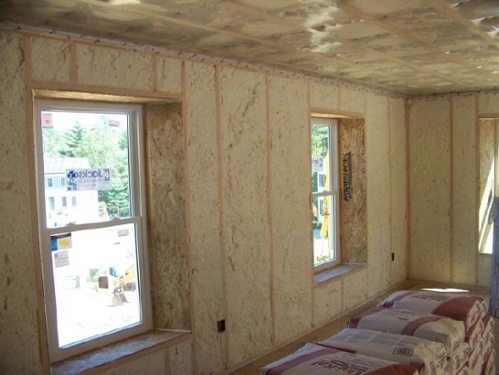
Insulation is good. More insulation is better (although at some point, more may not be cost effective). It reduces the amount of heat a home loses in winter or gains in summer. You can get there by building thicker walls and putting more insulation in the cavities, or you can put insulation on the outside of the structure, as in the Perfect Wall. The photo below shows thick insulation in the cavities of a home with double-wall construction.
When you do it by making the walls thicker, you also change the ability of an assembly to deal with moisture because the sheathing stays colder in winter, an issue that painters discovered back in the early days of insulating homes when walls stayed wet and paint peeled off. With a 2×4 or 2×6 wall, dealing with the rain on the outside of the wall is usually enough to prevent problems (unless you’re in an extremely cold climate). Going to thicker walls, though, especially double-wall construction with cavities that are 12″ thick, makes vapor diffusion of interior moisture a bigger threat. Building Science Corporation (BSC) recently published the latest results from its study of a double-wall home in Massachusetts and found a somewhat surprising result about cold sheathing getting wet.
The BSC study
BSC has been working with home builder Carter Scott of Transformations, Inc. on this Building America research project. Scott builds superinsulated homes in Massachusetts (climate zone 5A) using double-wall construction. The house in this study is wired up with a lot of sensors to measure temperature, moisture content, and relative humidity in various places (indoors, outdoors, and within the walls). The photo below shows the sensors in one of the walls. You can look at the full BSC report to get all the details about them.
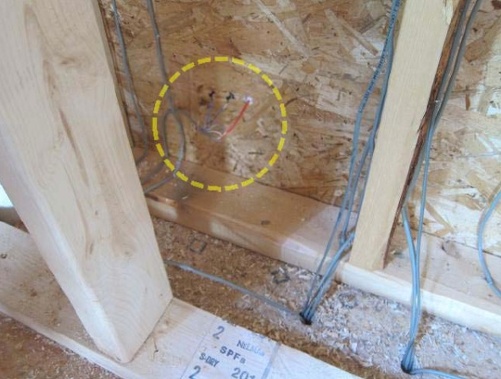
The BSC study used both cellulose insulation and open-cell spray polyurethane foam (ocSPF) insulation, and they monitored what happened to the OSB sheathing (Huber’s Zip System sheathing) over a three-year period on the south and north walls of the home. Further, they looked at two different thicknesses of ocSPF: 5.5″ and 12″. The cellulose was 12″ thick.
In this article, I’m going to focus on a few key questions:
- How wet does the exterior sheathing get?
- Where does the water come from?
- Does the wetting cause any problems?
How wet does the sheathing get?
The BSC report shows three years of data. The set of graphs below shows the moisture content (MC) in the three wall sections (12″ ocSPF, 12″ cellulose, & 5.5″ ocSPF) as well as the outdoor temperature. Keeping the moisture content of wood below 20% is considered to be safe. If the moisture content goes above 20%, there’s enough water to start growing mold and rot fungi.
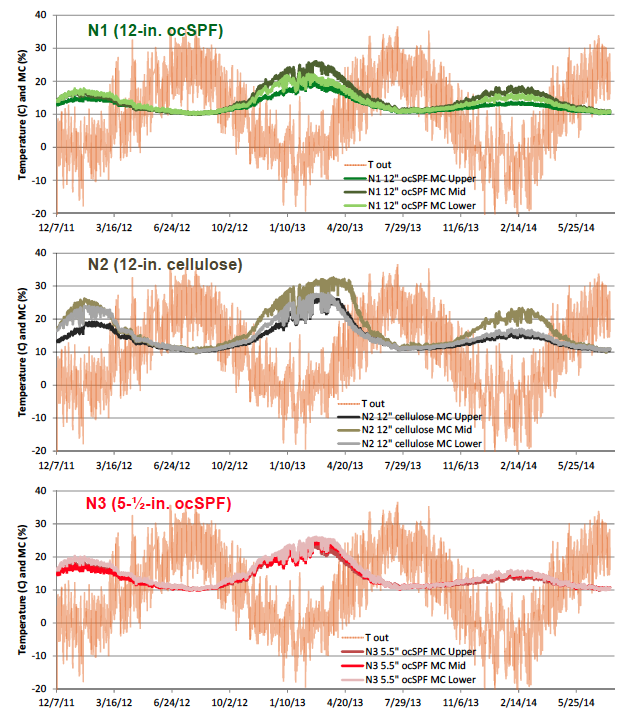
Notice that the two spray foam sections stay below 20% moisture content for all but a few months in the second winter. The sheathing next to the cellulose insulation goes above 20% in all three winters, at least in some places.
Clearly, though, the second winter showed the most potential for moisture problems. The moisture content of the OSB sheathing went above 20% for all three wall types. The good news is that by mid-summer, the moisture content was back down to about 10%.
The graphs above are for the north wall. The data from the south wall show the same basic pattern, but the moisture contents are all lower. The 12″ ocSPF, in fact, stayed below 20% all three winters. The 5.5″ ocSPF went slightly above 20%, and the cellulose section went up almost to 30%.
So, how did the walls get wet? And did the moisture cause problems?
Where does the water come from?
Water that gets into building assemblies can come from a variety of sources. It could be rain getting through bad window flashing or a roof leak. It could be ground water wicking up through the foundation and into the framing. It could also be from water vapor in the air. In this case, it’s the last of those.
The graph below shows the interior relative humidity (RH) in the basement and in the north and south rooms where the test walls were located. In the first and third winters, the RH spent a good amount of time between 10% and 20%. In the second winter, the RH spent a good amount of time above 40%.
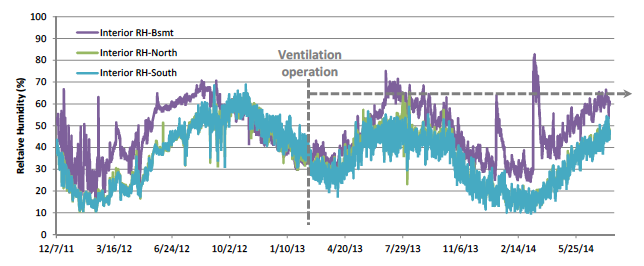
The first winter was dry because no one was living in the home yet. By the second winter, there were occupants but the ventilation system wasn’t operating until mid-February. After they started ventilating (exhaust-only, two 30 cfm fans), the air dried out and by the third winter, the indoor air was dry again.
Those numbers correlate with well with the changes in moisture content in the OSB sheathing. And that raises an interesting question: Do you need to keep the indoor RH below 30% to keep the sheathing in double-wall construction from getting wet? That’s a bit on the low side.
When I asked Kohta Ueno, the author of the BSC report, about this, he said low relative humidities are typical in New England. “I have *very* seldom seen houses running 40% RH through the entire winter around here.” Most homes, he said, run at about 20-30% RH through the winter, and he considers 40-50% RH to be “crazy-dangerous levels in a New England/Zone 5 type of climate.”
Does the wetting cause any problems?
Another really cool part of this study was what they did after three years of collecting temperature and moisture data: They took the walls apart and inspected them for signs of rot, mold growth, or other problems.
The photos below show the disassembly. The first one shows the north wall with siding and sheathing removed. You can see the three sections with different insulation.
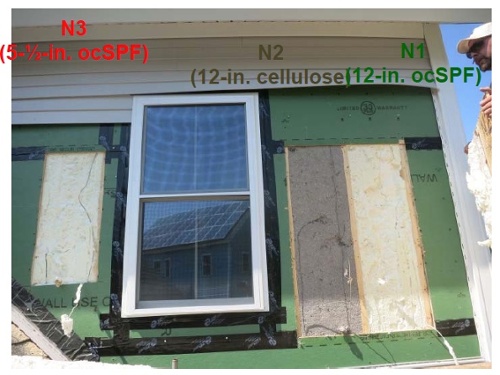
The second photo shows the sheathing from the south wall. They found no damage here and no evidence of mold or rot.
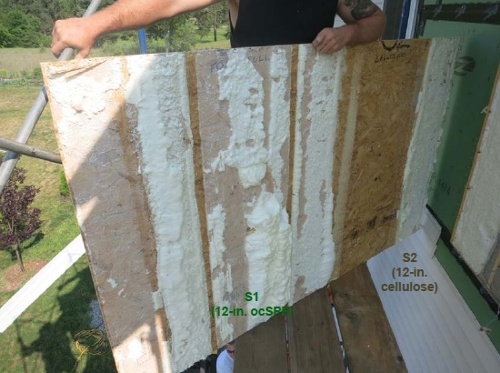
The final photo shows the north wall sheathing. They found no indication of mold or rot here either, although they did see some rust on the nails.

The results were surprising because the moisture content of the sheathing had gone so high in the second winter. In Martin Holladay’s 2013 article on this double-wall construction, Ueno is quoted as saying, “I don’t think it’s an issue. As Mark Bomberg says, ‘We measure the moisture content of wood during the winter but it rots during the summer.'”
When I spoke with him last week, though, he was a bit less sanguine about it. He told me the walls stayed wet long enough into spring that it was warm enough to grow mold. In the report’s conclusion, he wrote, “Based on the monitored data, calculations, and analysis, all three walls should have been at high risk of failure; the analytic tools used indicate that these walls should have failed.”
But taking the walls apart at the end of three years showed that they not only did not fail but were “essentially undamaged.” Ueno thinks it may be the borate added to cellulose that helped protect the sheathing in that wall. He proposes several hypotheses for the success of the spray foam walls, which had lower moisture content but still should have failed, but wrote in the report, “The protective mechanism of the ocSPF wall was not clear.”
In a Journal of Light Construction article on this study, Ueno told author Ted Cushman that Joe Lstiburek appears to be right. “Joe has said for years that building assemblies are more robust than we give them credit for. This is a solid demonstration of that fact.”
Addendum
4/22/15 This just in: I spoke with Joe Lstiburek today, and he wants to make sure it’s clear to readers that he does not recommend this wall assembly. “I would never build that wall because I consider it too risky,” he said. This was a research project for BSC, not a building that incorporated their design. Details at 11…or next Monday.
External Resources
Monitoring of Double-Stud Wall Moisture Conditions in the Northeast by Kohta Ueno, the latest BSC report on this home with double-wall construction
Moisture in Fat Walls—A Closer Look by Ted Cushman, Journal of Light Construction, an article about the latest BSC study
Monitoring Moisture Levels in Double-Stud Walls by Martin Holladay, Green Building Advisor, a nice review of what we know about moisture in double-wall construction, from 2013
Related Articles
The Diminishing Returns of Adding More Insulation
Why Did Painters Refuse to Paint Insulated Houses in the 1930s?
Combobulating the Perfect Wall – The Basics of Control Layers
All photos above are from the BSC report, used with permission from Building Science Corporation.
NOTE: Comments are moderated. Your comment will not appear below until approved.
This Post Has 38 Comments
Comments are closed.

Excellent article! It
Excellent article! It appears the BSC has more research to do to fully understand the dynamics of moisture in advanced wall components.
If you are running "
If you are running "exhaust-only" fans for a super tight home – where is the replacement air coming from?
We see this on the north side
We see this on the north side of sealed attics as well. I think it’s the lack of air that prevents the wood from growing bad stuff.
<b>Gary</b>: Yes,
<b>Gary</b>: Yes, they do. There are still a lot of open questions. <br /> <br /><b>Charles</b>: Good question. The house tested at 1.1 ACH50, so getting 60 cfm of ventilation air isn’t impossible. I don’t like exhaust-only ventilation, but a lot of builders go that route because it’s less expensive. <br /> <br /><b>Skye D.</b>: Lack of oxygen was one of the things Kohta discussed in the article, and he ended up deciding that couldn’t be it because mold needs very little oxygen to grow. <br /> <br />
What I’m seeing in this is
What I’m seeing in this is that if OSB can survive a double-wall assembly, let’s put our polymers into a much more permeable and rot resistant sheathing (or fabric) and we’ve got ourselves a reliable wall assembly.
OK – understood. With only 1
OK – understood. With only 1.1ACH50 I guess I wouldn’t put it in the "super-tight" category. I’m surprised it is so high for the attention the envelope was receiving.
Is it not true that mold
Is it not true that mold needs moisture, temperature and food to grow? Borate in the cellulose will check mold growth and foam is probably sterile when first applied. I assume the walls to be pretty well airsealed. Are there ways to monitor small amounts of air movement? Does the presence (and fluctuation) of moisture indicate air movement? Was there any indication of mold on the studs? OSB may be less desirable to mold spore since it is more intensely treated with heat and pressure in the manufacturing process than raw cellulose/studs. <br /> <br />What time of year was this house constructed and how much time transpired between framing and insulating? What was the moisture content of the studs at framing? <br /> <br />I guess I should read the entire report before burdening you with my questions. Thanks for doing this research and providing the findings. CS
I have been building double
I have been building double-wall homes since the early 80’s in CZ-6 and have never ever built one without a superior vapor retarder / air barrier in the "middle+/-" of the wall where its chances of being compromised are minimal. I have also never had a problem. <br /> <br />What the study says to me is that conditions were observed that should have created a problem, but didn’t over a very brief and inconsistent 3 year period of time. "Speculation" on why severe problems were not encountered are just that and not proof of any kind. Nails rusting in such a brief period of time gives me concern about what could happen in 10, 20 30, 50, or 100 years. Is this at all a sustainable way to build a structure? Not in my opinion!
I believe if you just use a
I believe if you just use a CLOSED cell foam (much better water/vapor/air/thermal barrier than either open cell or cellulose) with almost no thermal bridging in the wall then it kind of solves lots of problems all at once…
<b>Andy</b>: And
<b>Andy</b>: And that’s another option. Use fiberboard or gypsum sheathing, which are more vapor open, and they might not get as wet. <br /> <br /><b>Charles</b>: 1.1 ACH50 is not what most people would consider high…but won’t it be nice if we can ever get to the point where they do? <br /> <br /><b>Craig S.</b>: I’m not sure the paper answers all your questions, but many of them should be there. <br /> <br /><b>Thomas P.</b>: From what I understand, Joe used to recommend the vapor retarder in the middle of a double-wall and had it in his Builder’s Guides. Kohta told me, though, that he has since changed his mind on that and removed that recommendation from the book. If rain gets in from the outside, the vapor retarder in the middle prevents the wall from drying. <br /> <br />But you’re right. The three-year time frame of this study isn’t long enough to know for sure how this will work in the long term. <br /> <br />
Charles: The only problem
Charles: The only problem that the closed cell foam doesn’t solve is cost. <br /> <br />Allison: I will challenge Joe’s "change of mind". If the rain gets in from the outside (which it shouldn’t in a well constructed home), I would think that it could dry from the outside as easily, if not more so, than any inside drying could occur through a 12" wall. <br /> <br />Thanks for agreeing on the short time frame on the study.
<b>Charles</b>:
<b>Charles</b>: As with a vapor retarder in the middle, putting closed cell foam on the sheathing also prevents drying to the inside. That would make a vented rainscreen essential. <br /> <br /><b>Thomas P.</b>: If you’ve been doing it your way for decades and haven’t had a problem, that says a lot. But have you opened up any of the walls to see? That would be interesting. <br />
Excellent article! It
Excellent article! It appears the BSC has more research to do to fully understand the dynamics of moisture in advanced wall components.
Thanks for sharing, I have
Thanks for sharing, I have been trying to follow this issue very closely. I recall a similar study discussed at GBA a bit ago that found similar conclusions, but was done on walls with a full rainscreen gap, which was hypothesized as a contributor to the walls’ ability to dry out by spring/summer. That didn’t make tons of sense to me if the majority of the moisture was coming in from vapor diffusion from the interior. It is an interesting development to see a similar result in walls without a rainscreen gap or even houswrap. <br /> <br />We need a study like this in climate zone 4, where interior RH levels don’t tend to drop as low, interior vapor retarders are not often used, but extremes of cold temperatures are not as great (except during Polar Vortexes.) I do see some double stud walls (although not many) being built here in the NC mountains.
If you are running "
If you are running “exhaust-only” fans for a super tight home – where is the replacement air coming from?
We see this on the north side
We see this on the north side of sealed attics as well. I think it’s the lack of air that prevents the wood from growing bad stuff.
Gary: Yes,
Gary: Yes, they do. There are still a lot of open questions.
Charles: Good question. The house tested at 1.1 ACH50, so getting 60 cfm of ventilation air isn’t impossible. I don’t like exhaust-only ventilation, but a lot of builders go that route because it’s less expensive.
Skye D.: Lack of oxygen was one of the things Kohta discussed in the article, and he ended up deciding that couldn’t be it because mold needs very little oxygen to grow.
What I’m seeing in this is
What I’m seeing in this is that if OSB can survive a double-wall assembly, let’s put our polymers into a much more permeable and rot resistant sheathing (or fabric) and we’ve got ourselves a reliable wall assembly.
OK – understood. With only 1
OK – understood. With only 1.1ACH50 I guess I wouldn’t put it in the “super-tight” category. I’m surprised it is so high for the attention the envelope was receiving.
Is it not true that mold
Is it not true that mold needs moisture, temperature and food to grow? Borate in the cellulose will check mold growth and foam is probably sterile when first applied. I assume the walls to be pretty well airsealed. Are there ways to monitor small amounts of air movement? Does the presence (and fluctuation) of moisture indicate air movement? Was there any indication of mold on the studs? OSB may be less desirable to mold spore since it is more intensely treated with heat and pressure in the manufacturing process than raw cellulose/studs.
What time of year was this house constructed and how much time transpired between framing and insulating? What was the moisture content of the studs at framing?
I guess I should read the entire report before burdening you with my questions. Thanks for doing this research and providing the findings. CS
I have been building double
I have been building double-wall homes since the early 80’s in CZ-6 and have never ever built one without a superior vapor retarder / air barrier in the “middle+/-” of the wall where its chances of being compromised are minimal. I have also never had a problem.
What the study says to me is that conditions were observed that should have created a problem, but didn’t over a very brief and inconsistent 3 year period of time. “Speculation” on why severe problems were not encountered are just that and not proof of any kind. Nails rusting in such a brief period of time gives me concern about what could happen in 10, 20 30, 50, or 100 years. Is this at all a sustainable way to build a structure? Not in my opinion!
Any info on how the interior
Any info on how the interior side of the wall was treated regarding vapor? Were they relying on the latex paint as a vapor retarder? Did they seal the electrical boxes? Smart vapor membrane? <br /> <br />I’m just thinking that this kind of wall assembly allows moisture to move sideways much more readily than an ordinary stud wall. I’d like to see how the moisture level at the sheathing compares to a wall with interior side air sealing and vapor control.
I believe if you just use a
I believe if you just use a CLOSED cell foam (much better water/vapor/air/thermal barrier than either open cell or cellulose) with almost no thermal bridging in the wall then it kind of solves lots of problems all at once…
Andy: And
Andy: And that’s another option. Use fiberboard or gypsum sheathing, which are more vapor open, and they might not get as wet.
Charles: 1.1 ACH50 is not what most people would consider high…but won’t it be nice if we can ever get to the point where they do?
Craig S.: I’m not sure the paper answers all your questions, but many of them should be there.
Thomas P.: From what I understand, Joe used to recommend the vapor retarder in the middle of a double-wall and had it in his Builder’s Guides. Kohta told me, though, that he has since changed his mind on that and removed that recommendation from the book. If rain gets in from the outside, the vapor retarder in the middle prevents the wall from drying.
But you’re right. The three-year time frame of this study isn’t long enough to know for sure how this will work in the long term.
Charles: The only problem
Charles: The only problem that the closed cell foam doesn’t solve is cost.
Allison: I will challenge Joe’s “change of mind”. If the rain gets in from the outside (which it shouldn’t in a well constructed home), I would think that it could dry from the outside as easily, if not more so, than any inside drying could occur through a 12″ wall.
Thanks for agreeing on the short time frame on the study.
Allison, <br /
Allison, <br /> <br />I have had no need to open up any of the wall systems. The one problem that I am aware of was when an exterior patio swing door, whose brand was know for leaking, did leak into the exterior of the wall. It was not addressed for several years and rot was the result, however, I doubt that the lack of a vapor retarder would have helped it to dry to the inside and may well have caused more damage.
Charles:
Charles: As with a vapor retarder in the middle, putting closed cell foam on the sheathing also prevents drying to the inside. That would make a vented rainscreen essential.
Thomas P.: If you’ve been doing it your way for decades and haven’t had a problem, that says a lot. But have you opened up any of the walls to see? That would be interesting.
Thanks for sharing, I have
Thanks for sharing, I have been trying to follow this issue very closely. I recall a similar study discussed at GBA a bit ago that found similar conclusions, but was done on walls with a full rainscreen gap, which was hypothesized as a contributor to the walls’ ability to dry out by spring/summer. That didn’t make tons of sense to me if the majority of the moisture was coming in from vapor diffusion from the interior. It is an interesting development to see a similar result in walls without a rainscreen gap or even houswrap.
We need a study like this in climate zone 4, where interior RH levels don’t tend to drop as low, interior vapor retarders are not often used, but extremes of cold temperatures are not as great (except during Polar Vortexes.) I do see some double stud walls (although not many) being built here in the NC mountains.
<b>Update</b> I
<b>Update</b> I spoke with Joe Lstiburek today, and he wants to make sure it’s clear to readers that he does not recommend this wall assembly. "I would never build that wall because I consider it too risky," he said. This was a research project for BSC, not a building that incorporated their design. I’ll write another article about his thoughts and what he <i>does</i> recommend.
Any info on how the interior
Any info on how the interior side of the wall was treated regarding vapor? Were they relying on the latex paint as a vapor retarder? Did they seal the electrical boxes? Smart vapor membrane?
I’m just thinking that this kind of wall assembly allows moisture to move sideways much more readily than an ordinary stud wall. I’d like to see how the moisture level at the sheathing compares to a wall with interior side air sealing and vapor control.
Allison,
Allison,
I have had no need to open up any of the wall systems. The one problem that I am aware of was when an exterior patio swing door, whose brand was know for leaking, did leak into the exterior of the wall. It was not addressed for several years and rot was the result, however, I doubt that the lack of a vapor retarder would have helped it to dry to the inside and may well have caused more damage.
Update I
Update I spoke with Joe Lstiburek today, and he wants to make sure it’s clear to readers that he does not recommend this wall assembly. “I would never build that wall because I consider it too risky,” he said. This was a research project for BSC, not a building that incorporated their design. I’ll write another article about his thoughts and what he does recommend.
Well that certainly clears up
Well that certainly clears up the controversy. All homes should now be constructed with ICF’s <br /> <br />We must learn how to design walls and houses that can withstand 35% to 40% RH. Comfort, health and wellness, as well as material stability demand it.
Well that certainly clears up
Well that certainly clears up the controversy. All homes should now be constructed with ICF’s
We must learn how to design walls and houses that can withstand 35% to 40% RH. Comfort, health and wellness, as well as material stability demand it.
For Greg L.V. – I’m pretty
For Greg L.V. – I’m pretty sure latex paint on the drywall is the only vapor retarder on the inside. <br /> <br />Also, whether or not they sealed the electrical boxes doesn’t really matter here…the house is tight AND they are using continuous exhaust ventilation…so in the winter, cold/dry air from outside would be pulled into the walls (rather than warm/moist air from the inside).
For Greg L.V. – I’m pretty
For Greg L.V. – I’m pretty sure latex paint on the drywall is the only vapor retarder on the inside.
Also, whether or not they sealed the electrical boxes doesn’t really matter here…the house is tight AND they are using continuous exhaust ventilation…so in the winter, cold/dry air from outside would be pulled into the walls (rather than warm/moist air from the inside).
@Allison, thanks for covering
@Allison, thanks for covering this. There was a thread about this in one of the LinkedIn building science groups, which I imagine you saw. Interesting stuff. I agree with Thomas (and Joe) that this wall, though no damage in 3 years with some high moisture peaks, is too risky over the long haul.
@Allison, thanks for covering
@Allison, thanks for covering this. There was a thread about this in one of the LinkedIn building science groups, which I imagine you saw. Interesting stuff. I agree with Thomas (and Joe) that this wall, though no damage in 3 years with some high moisture peaks, is too risky over the long haul.